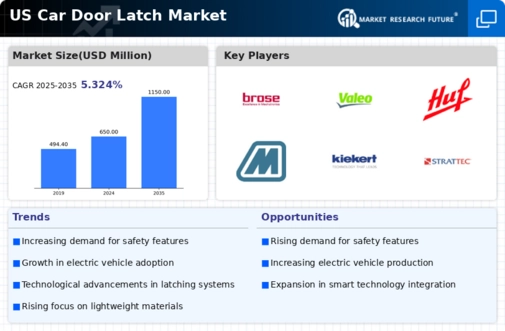Rising Vehicle Production
The car door-latch market is experiencing growth due to the increasing production of vehicles in the US. In 2025, the automotive industry anticipates producing approximately 15 million vehicles, which directly correlates with the demand for door-latch systems. As manufacturers strive to enhance vehicle safety and functionality, the integration of advanced latching mechanisms becomes essential. This trend is likely to drive innovation within the car door-latch market, as companies seek to develop products that meet evolving consumer expectations. Furthermore, the competitive landscape encourages manufacturers to invest in research and development, potentially leading to the introduction of more efficient and reliable latching systems. The rising vehicle production not only boosts the demand for car door-latch systems but also stimulates the overall automotive supply chain, creating a favorable environment for market growth.
Consumer Demand for Enhanced Security
In the current landscape, consumers are increasingly prioritizing vehicle security, which significantly impacts the car door-latch market. With rising concerns about vehicle theft and vandalism, manufacturers are compelled to innovate and enhance the security features of door-latch systems. Advanced locking mechanisms, such as electronic latches and biometric access, are gaining traction among consumers. This shift in consumer preferences is reflected in market data, indicating that the demand for high-security latching systems has surged by approximately 20% in recent years. As a result, manufacturers are investing in the development of more sophisticated latching solutions to meet these demands. The emphasis on security influences product design and shapes marketing strategies within the car door-latch market. Companies aim to highlight the safety features of their products to attract consumers.
Growth of Electric and Autonomous Vehicles
The emergence of electric and autonomous vehicles is reshaping the car door-latch market. As the automotive industry transitions towards electrification and automation, the demand for innovative latching solutions is expected to rise. Electric vehicles (EVs) often require specialized door-latch systems that accommodate unique design features and enhance user experience. Furthermore, autonomous vehicles necessitate advanced latching mechanisms that ensure safety and reliability during operation. Market analysts project that the growth of electric and autonomous vehicles could lead to a 25% increase in demand for specialized door-latch systems by 2030. This shift presents both challenges and opportunities for manufacturers in the car door-latch market, as they must adapt to new technologies and consumer expectations while maintaining high safety standards.
Regulatory Compliance and Safety Standards
The car door-latch market is significantly influenced by regulatory compliance and safety standards imposed by government agencies. In the US, the National Highway Traffic Safety Administration (NHTSA) has established stringent regulations regarding vehicle safety, including door-latch performance. Compliance with these regulations is essential for manufacturers, as failure to meet safety standards can result in costly recalls and legal repercussions. As a result, manufacturers are increasingly investing in research and development to ensure their products adhere to these regulations. This focus on compliance not only enhances the safety of vehicles but also drives innovation within the car door-latch market, as companies strive to develop latching systems that exceed regulatory requirements. The ongoing evolution of safety standards is likely to continue shaping product development and market dynamics in the coming years.
Technological Advancements in Manufacturing
The car door-latch market is benefiting from technological advancements in manufacturing processes. Innovations such as automation and 3D printing are streamlining production, reducing costs, and improving product quality. In 2025, it is estimated that automated manufacturing techniques could reduce production costs by up to 15%, allowing manufacturers to offer competitive pricing for their door-latch systems. Additionally, the adoption of smart manufacturing technologies enables real-time monitoring and quality control, ensuring that products meet stringent safety standards. These advancements not only enhance the efficiency of production but also foster innovation within the car door-latch market, as companies are better equipped to develop new and improved latching solutions. As the industry continues to evolve, the integration of advanced manufacturing technologies is likely to play a crucial role in shaping the future of the market.























Leave a Comment